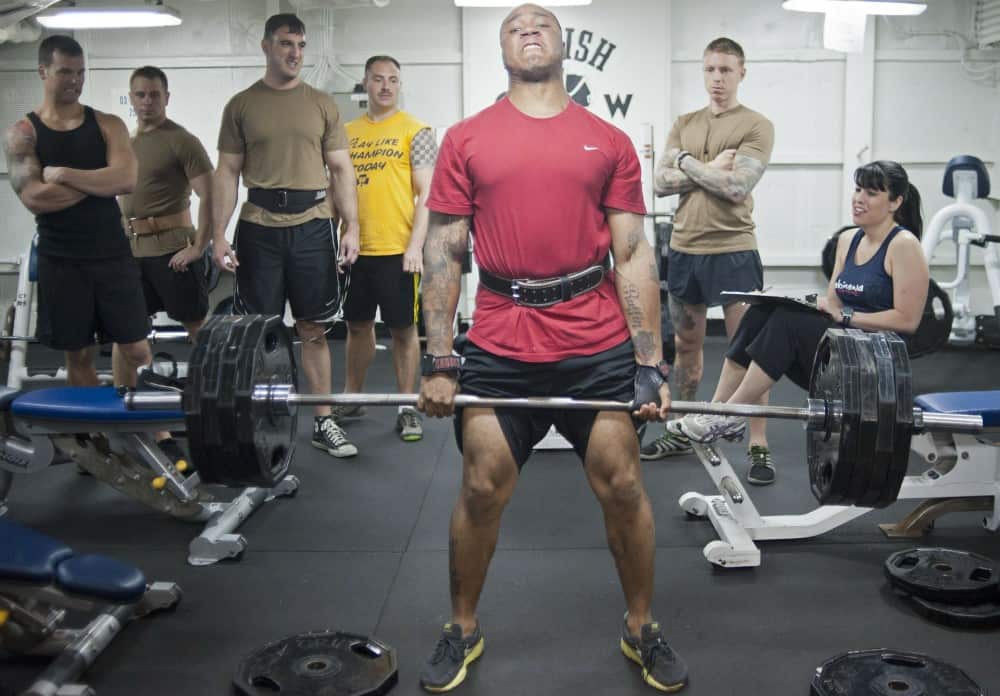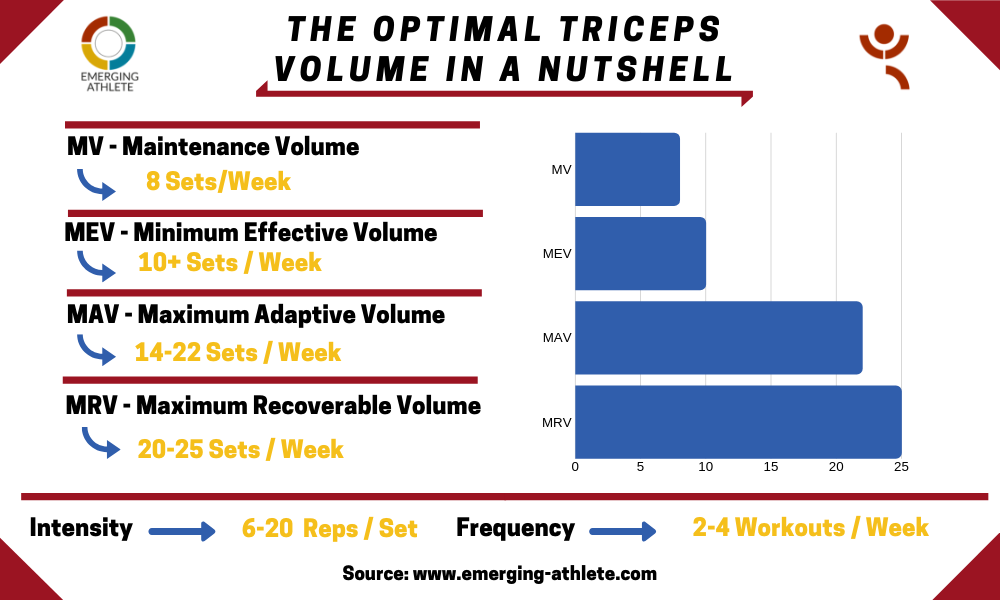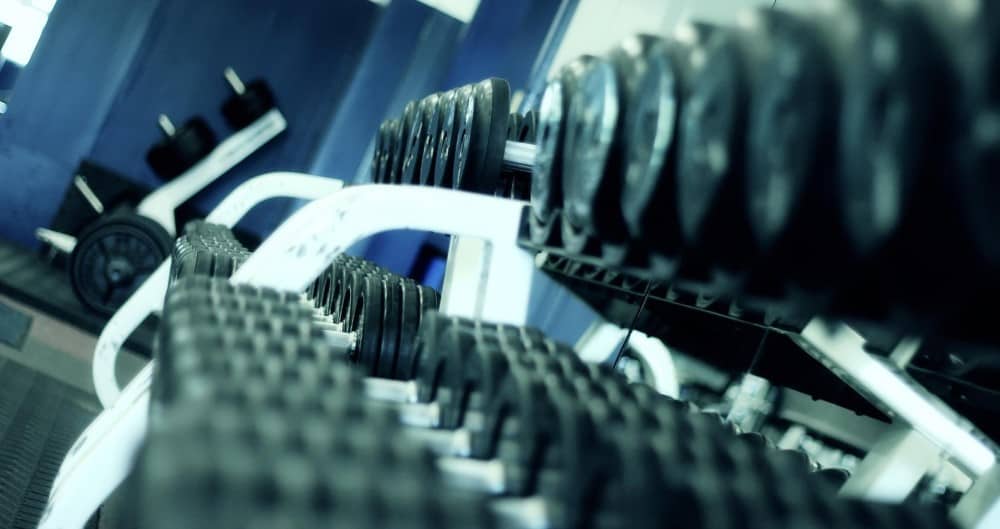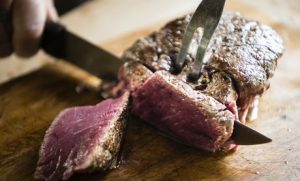The second article of our volume series will take a look at the optimal back volume.
This article series will cover all crucial parameters that concern the optimal volume. This facilitates the process of developing your very own training program.
If you’re not yet familiar with what volume is and how it affects the muscle-building process, check out the following highlighted complete guide about the optimal volume for hypertrophy.
As a brief preview, what can you expect from this article series? Well, based on Dr. Mike Israetel’s knowledge, as well as our own experience from working with clients and athletes, we want to clarify the most effective volume landmarks.
Thus, in today’s article, we will dive deeper into the optimal back volume and present benchmarks that you can use as starting points.

MV – Maintenance Volume
MV stands for “Maintenance Volume“.
In other words, the minimum amount of work that is required to maintain your muscles current size.
Why is it important to know your MV?
This belongs to one of the more rewarding aspects of bodybuilding.
Building muscles is apparently harder than maintaining or regaining.
This is important since everybody needs to take a break or reduce the frequency for some time somewhen.
And I suppose you don’t want to lose your hard-acquired gains, do you?
Moreover, after one or more mesocycles of heavy workouts in between your MAV and MRV (or even above your MRV), it is for sure a good thing to lower your volume now and then.
Thereby, joints, tendons, ligaments, and muscle tissue can fully recover.
For that reason, it is crucial to know where the MV can be put about to avoid losing muscle size.
Likewise, you want to avoid going too crazy during the “deload phase”. Otherwise, you most likely miss the underlying reason for a deload in the first place.
Don’t know what a so-called Deload is? Don’t worry, I wrote a separate guide that covers all important aspects. Just click the highlighted link.
Where can we set a point of reference for the optimal back volume?
MV: 8 sets / week
On average around 8 sets per week is enough to maintain your back’s current size.
This means you could do 4 sets of heavy rows on Monday and 4 sets of pull-ups on Thursday.
It’s as simple as that…
MEV – Minimum Effective Volume
After we covered the MV (Maintenance Volume) that is compulsory to maintain your current size, we surely want to know how much volume is essential to add size, right?
For that, we need to take the Minimum Effective Volume into consideration.
The MEV refers to the minimum amount of work that leads to bigger and stronger muscles.
Why is it important to know your MEV?
Well, that is simple.
Just as it significant to know how much volume the back requires to keep its current size, it is at least of similar importance to know how much volume is required to strengthen and increase size.
How many sets should be done at a minimum?
MEV: 10+ sets / week
Most individuals need at least 10 sets each week to grow their back.
So if your current back program contains less than 10 sets, that is probably not enough to achieve progress.
Thus, I would recommend sticking with at least 10 sets per week when compiling your program.
For example, you could start the first week with 10 sets and over time slowly raise the volume by adding sets, reps and extending the working weights.
Once again, you should consider all these values as benchmarks and not as fixed values!
MAV – Maximum Adaptive Volume
That’s all well and good, but we don’t want to stay all the time within the MEV (minimum effective volume), right?
Exactly, we want to maximize efforts to get the best possible results.
Along these lines, the Maximum Adaptive Volume comes into play.
Why is it important to know your MAV?
Let me answer that question with another question.
Do you want to train all the time with the least effective volume?
Exactly, I highly doubt that!
In order to get the best results, we need to put more effort into our workout and increase the volume gradually.
Accordingly, it is important to know your MAV in order to convert all the pain, sweat and time into muscle growth.
So, how much volume do we need to stimulate the most effective muscle growth?
MAV: 14-22 sets / week
With around 14-22 sets per week, the back muscles tend to respond with extensive growth.
Therefore, the optimal back volume is on average somewhere between 14 and 22 sets per week.
Practically, when you start your mesocycle with an MEV around 10 sets work you’re way up gradually. Somewhere between 14-22 sets will probably be your MAV.
The best way to unravel your MAV is by actually using the trial-and-error method.
But is your MAV steady?
No, of course not.
These values shift over time. However, that is only logical as you (or at least should) make progress and gain bigger muscles sooner or later.
Eventually, this is why it is so important to take these recommendations as benchmarks.
Adjust them to your current workout level and experience.
MRV – Maximum Recoverable Volume
After some weeks of training in your mesocycle, presumably, you will get into a state of overreaching the MRV (The Maximum Recoverable Volume).
What does that mean?
The MRV refers to the Maximum Recoverable Volume which your body can recover properly.
In other words, the maximum amount of work that you can sustain before your strength and performance might decrease. This occurs when lacking adequate rest.
Why is it important to know your MRV?
Briefly speaking, nobody wants to take a break just because having added too much volume yourself, right?
Therefore, it is crucial to know your MRV to keep your body recovered and avoid redundant breaks.
At what volume is it likely to overreach the MRV?
MRV: 20-25 sets / week
Most individuals will be able to recover fully from 20-25 sets each week.
Accordingly, a good point of reference for most folks is around 20-25 sets per week.
The back is composed of big muscles which equally have the ability to sustain relatively large volumes.
But again, these are not rigid values, simply benchmarks which you should use as a point of reference.
On the one hand, some people might already overreach their MRV with less than 20 sets but on the other hand, others can even go higher than 25 sets per week.
Therefore, the one and only formula:
adjust your workout program over each week and increase the volume slowly.
When you reach a point where you’re performance begins to stagnate for a whole week or even decrease, it is most likely that you’ve already exceeded your MRV!
Now, after we covered the basic volume parameters for the different stages, we will take a look at other important variables and how they influence the optimal back volume.

Frequency
What about the frequency?
How often should we train our back each week to get the optimal back volume?
2-4 times/week
For most individuals, 2-4 heavy back workouts per week will work most effectively.
I would not recommend working with more than 4 workouts because the back is a really big muscle that takes a lot of damage and accordingly needs its time to recover.
So, anything above 4 overloading workouts per week is likely too much.
Intensity
How intense can we train our back?
Generally, we can say that a rep range between 6-20 is beneficial for most people.
When training our back it is important that we use challenging weights because it seems that the back tends to respond most positively to high forces around 6-8 reps.
But, of course, this will vary individually.
For some folks, a low rep range around 6-8 will work fine whereas others do not really get a good feeling with that, ultimately leads to a preference for higher rep ranges around 10-15.
However, some people even need 20+ reps to feel their back properly.
But if you’re doing more than 20 reps on average you’re probably not getting any bigger. This is more endurance than strength training.
Same applies for rep ranges any lower than 6-8.
It is most likely that you’re becoming stronger but you will not get that much bigger either.
Nonetheless, rep ranges over 6-8 reps can be appropriate for your current stance and goal.
Moreover, it is important to not solely work with one fixed rep range and include some variety into your workouts.
I would recommend using both, lower = heavier and higher = lighter rep ranges.
This enables you to combine the benefits of both worlds.
Back workout – Exercises
Considering the back workout, we can split the exercises into two groups.
Horizontal Pulling Exercises:
- Barbell Bent Over Row
- Row to Chest
- One-Arm Dumbbell Row
- Two-Arm Dumbbell Row
- Chest Supported Row
- Rowing Machine
- Cable Row
Vertical Pulling Exercises:
- Overhand Pull-up
- Parallel Pullup
- Underhand Pullup
- Wide Grip Pullup
- Narrow Grip Pullup
- “Normal” Pulldown
- Parallel Pulldown
- Underhand Pulldown
- Wide Grip Pulldown
- Narrow Grip Pulldown
Here the same as for the chest exercises applies.
You can vary the width of your grip into a lot of different positions (narrow, wide…).
I recommend you don’t stick to one single variation (unless you found the best method for your body).
So, feel free and try out different variations every so often.
Range of motion
When we talk about the optimal back volume, we can identify two different approaches to train the back muscles.
Vertical & Horizontal pulling movements
A lot of people fail to use a proper range of motion as well as neglecting full stretch. With that, they waste a lot of potential for muscle growth.
It is really important to stretch and contract your back properly. Studies have shown that full contraction and stretch activates more muscles and eventually maximizes muscle growth.
What’s the point in using heavy weights that you can’t control and using merely a restricted range of motion?
Eventually, you’re your own worst enemy…
I would recommend to at least train your back from both angles when striving for a fully developed back.
This is because our back is composed of a lot of different muscle fibers. Means, you cannot just do pull-ups every workout and expect a fully developed back.
However, you don’t necessarily have to include vertical and horizontal exercises in every workout, but over your weekly/monthly cycles, you should definitely keep an eye on that to find a good balance!
For example, you could one day prioritize horizontal pulling exercises and focus your second workout on vertical pulling exercises.
Another option could be splitting your workouts in vertical and horizontal emphasis on a weekly basis instead of changing each workout.
Nonetheless, I would not recommend going with a full month only vertical or horizontal prioritization.
A balanced 50/50 split with both vertical and horizontal pulling exercises is most likely to result in great progress for a fully developed back.
Personally, I would prefer the split during the workouts of the week but that’s only my personal preference.
Just give it a shot and see what works best for you, guys.
Conclusion
What is important to keep in mind regarding the optimal back volume?

Exercises: Vertical/Horizontal pulling movements.
We recommend combining both angles in a balanced 50/50 split.
Either focus a whole week on vertical and then next week horizontal pulling exercises or during the week.
Prioritize one workout on vertical and the other workout on horizontal pulling movements.
Give both a shot and figure out what works best for you.
The range of motion:
It is important to fully stretch and contract your back to maximize your gains and activate as many muscles possible.
Here again, keep your ego outside of the gym. You should still use heavy weights, but only the ones that you can control properly!

Practical tips
In this section, we will give you some basic practical training tips that you can apply to your workout now and then to increase the variety and make it a bit more exciting.
Supersets: heavy compound exercise + isolation exercise or vice versa
A good technique to save time during your workout and get a great pump are supersets.
You can start with the isolation movement for a couple of reps and directly afterward you’re going to a pre-loaded rowing exercise and do a set.
Because you already hit your back with the isolation movement, your back is most likely to be the limiting factor and not your biceps or forearms.
The other way around works as well. Means you start with your heavy compound exercise (any row variation or rack pulls) and again directly after your set is done you do an isolation movement for another couple of reps.
This will leave you with a bit more power in your first exercise and then give you a great way to finish your back after you’ve already done heavy reps.
For further information, check out my article about supersets.
Giant sets:
How does it work?
Relatively simple, set yourself a total repetition number and do as many sets as you need to get to that total number.
For example, you want to do 100 pulldowns. In the first set, you do 20 reps, second 17, third 15 and so on. Continue until you accomplish that 100 reps.
This is a good technique to get a lot of volume in and get a really good pump. But the core of your back workout should consist of straight sets with some extent to muscle failure.
Special shout-out to Dr. Mike Israetel, we really value his knowledge and the content that he shares with you guys on his YT channel and his blog.
We highly recommend to check out his video and article about back volume!
If you have any further questions about the optimal back volume or any workout related topic, please feel free to leave a comment below or contact us through our social media channels.
Now after I’ve talked quite a lot, I am interested in you guys.
How does your optimal back volume workout routine look like? What is the exercise which brought you the best results?
Leave a comment below and share your experiences with us!
Cheers,
Claas




